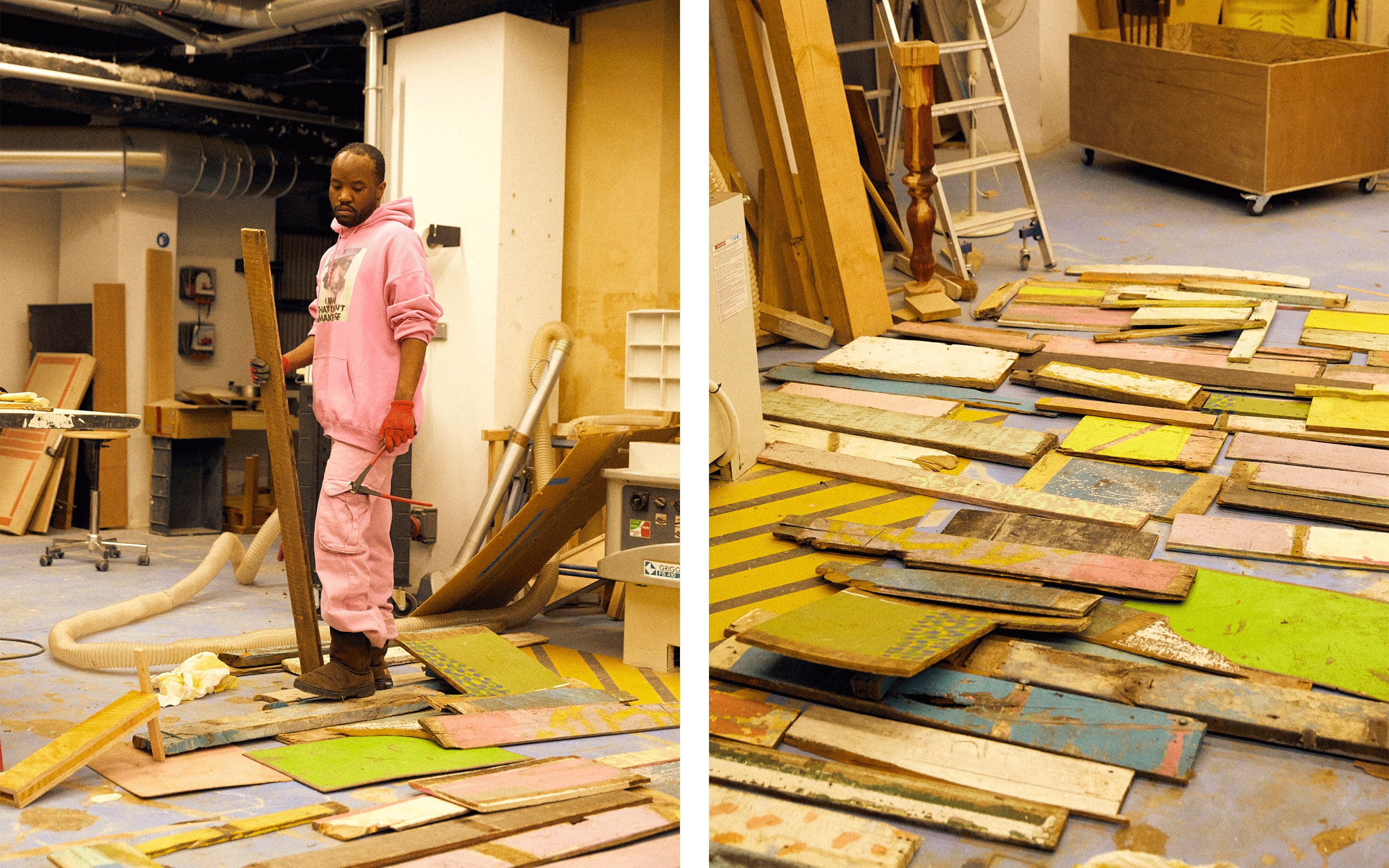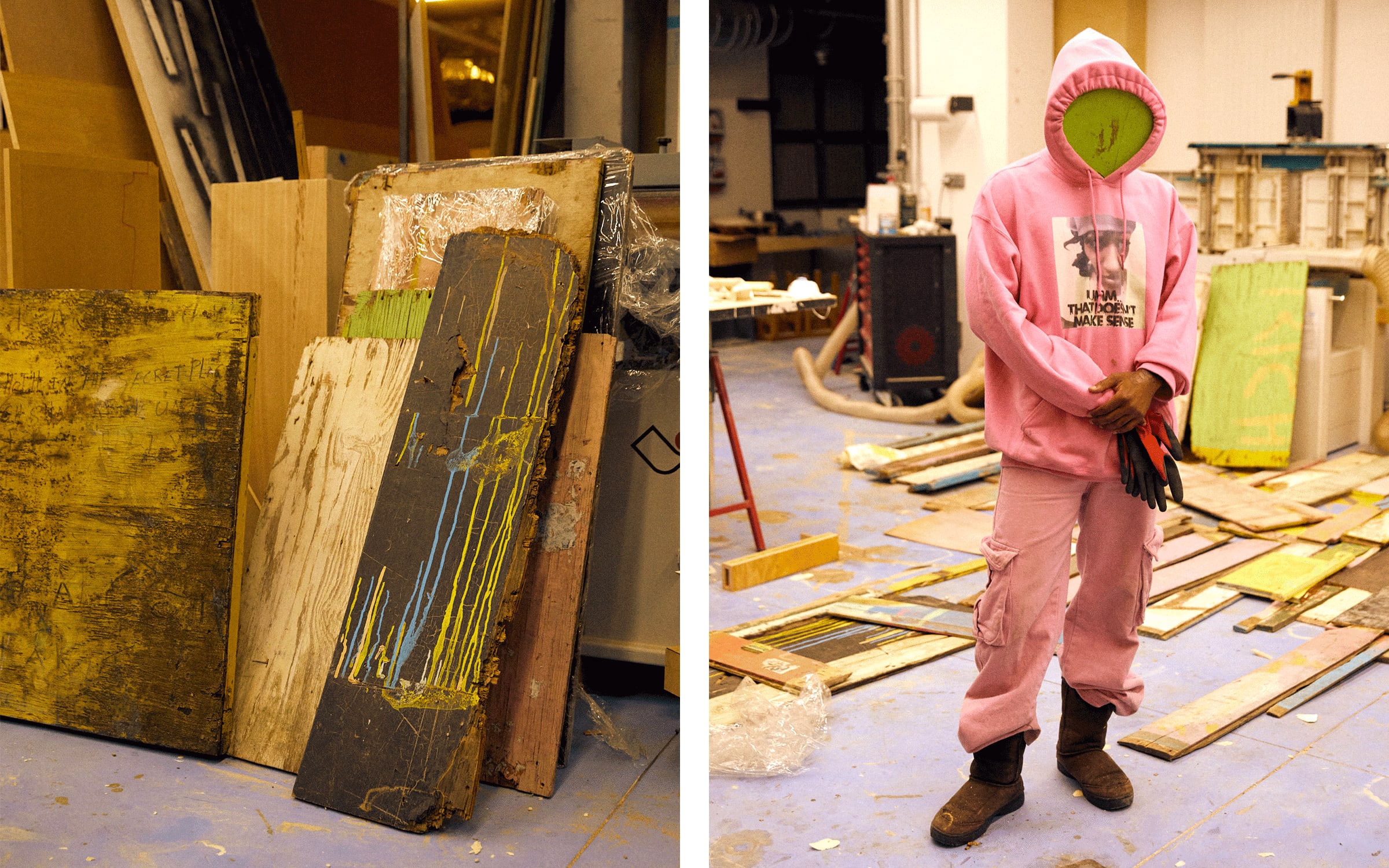Still in his early 30s, Akeem Smith has already become a key figure in both fashion and art. Not only have his designs become fashion staples, but his artworks have also been shown internationally in major institutions such as the Canadian Centre for Architecture, Montreal and the Centre d’Art Contemporain, Geneva. Smith also made a strong impression in Paris last October, when he became the 2022 recipient of Lafayette Anticipations’ Production Support Programme for his solo presentation at Paris+ par Art Basel. This summer, the New York-born and Jamaica-raised fashion designer, stylist, and artist has been awarded a residency at Lafayette Anticipations, in the heart of Paris, as well as a production grant to create a new body of work which will be presented at the private institution during the fall.
Smith’s career has its roots in fashion; he first studied costume design at Columbia College Chicago and then textile development at the Fashion Institute of Technology in New York. In the late 2000s, the New York fashion world provided a setting which allowed his career to flourish. As a figure in the underground scene, he came to work with some of the industry’s most reputed names such as Hood By Air and Helmut Lang – before going on to front Section 8, which began as an anonymous collective in 2017.
His interest in the visual arts has been a continuous and evolving process. When I meet him at his Lafayette Anticipations studio he tells me ‘There was no moment’ which marked his first entry into the field, adding: ‘I’m still developing my practice.’ For Smith, art offers a prime space for experimentation, one which can allow for ‘meaning’ to be stretched ‘beyond the obvious,’ he says. Such nuances can be found within the everyday, which he defines as ‘social and literal clutter.’

Fashion and art exist separately in Smith’s work: ‘They do not cross-pollinate,’ he says. The notion of time is indeed handled very differently; the fast-paced quality of changing trends seen in fashion, stands in contrast to the research-based process found in Smith’s art. Yet as a self-described ‘creative entrepreneur,’ there is also a certain sense of fluidity across both areas; an artful approach to clothes on the one hand, and a keen eye for texture in his artistic practice on the other, where the ordinary is turned into the spectacular.
His artistic process ranges from gleaning materials and objects from his surroundings to large-scale sculptures combining assemblage, photography, and video. His first major solo exhibition, ‘No Gyal Can Test’ at Red Bull Arts New York in 2020, included works made from debris found in his childhood home in Jamaica. From wood to wrought iron, these found materials were formed into monumental installations that sublimated their original detrital quality.
Smith’s photographic and video practice is based on an archival process, which, similarly to his three-dimensional work, consists of assembling different materials found in the drawers of people close to him and his family. They capture life in Jamaica from the 1990s until the present day, particularly Kingston’s nocturnal life, including the dancehall culture in which his grandmother keenly participated. These archives are defined by Smith as ‘shadow archives’; they exist as counter-narratives to official institutional histories.
As part of his residency at Lafayette Anticipations, Smith is now working on a new series of sculptural works made of materials also found in Jamaica. He describes how the concept of the urn, understood in its metaphorical sense, has come to underpin these new works for the first time: ‘No one ever opens it,’ he says. ‘No one ever really knows what’s actually inside. There is this object, which is really just an ashtray. But it is actually a valuable object. I want to create that.’
The urn comes to represent the idea of the found object, the found image, and the archive. Far from being associated with death and the funereal, for Smith it embodies the very notion of memory: ‘There is no body without memory, the body is a memory box,’ he explains. His work as a whole becomes a symbol of memory as a living entity – one which continuously informs the present.
While many of the materials he assembles in his work are related to his own family and childhood, he nonetheless maintains a certain distance. ‘It’s barely about my experience,’ he claims. ‘I’m almost like an historian. There’s a lot of missing first-person narrative within Black and Indigenous history and I’m trying to reverse that through my art,’ he adds. ‘You could use it as a footnote or maybe as some serious reference for something one day. That’s one of my goals.’
In delving into his personal life, Smith creates a vital space for the collective memory of Afro-Caribbean history and culture that charts a nation’s process from decolonization to the establishment of an independent Indigenous identity, and, in doing so, helps understand its place within contemporary culture.

Akeem Smith is represented by Heidi (Berlin).
As an official partner of Paris+ par Art Basel, the Galeries Lafayette group supports the Emerging Galleries sector, for which the Foundation offers an annual exhibition grant to an artist. Akeem Smith benefits from the production of a new work, as well as its presentation at the Foundation during Paris+ par Art Basel.
The next laureate of the Galeries Lafayette group's Production Support Programme will be selected by an international jury of art world professionals, composed by: Ruba Katrib, Director of Curatorial Affairs at MoMA PS1; Diana Campbell Bétancourt, Artistic Director of the Samdani Art Foundation in Bangladesh and Chief Curator of the Dhaka Art Summit; Akeem Smith, resident artist at Lafayette Anticipations and 2022 winner of the Production Support Programme; Rebecca Lamarche-Vadel, Director of Lafayette Anticipations; and Guillaume Houzé, President of Lafayette Anticipations.
Juliette Desorgues is a writer and curator based in Paris.
All photos and videos by Mathieu Richer Mamousse for Art Basel.
Published on July 27, 2023.